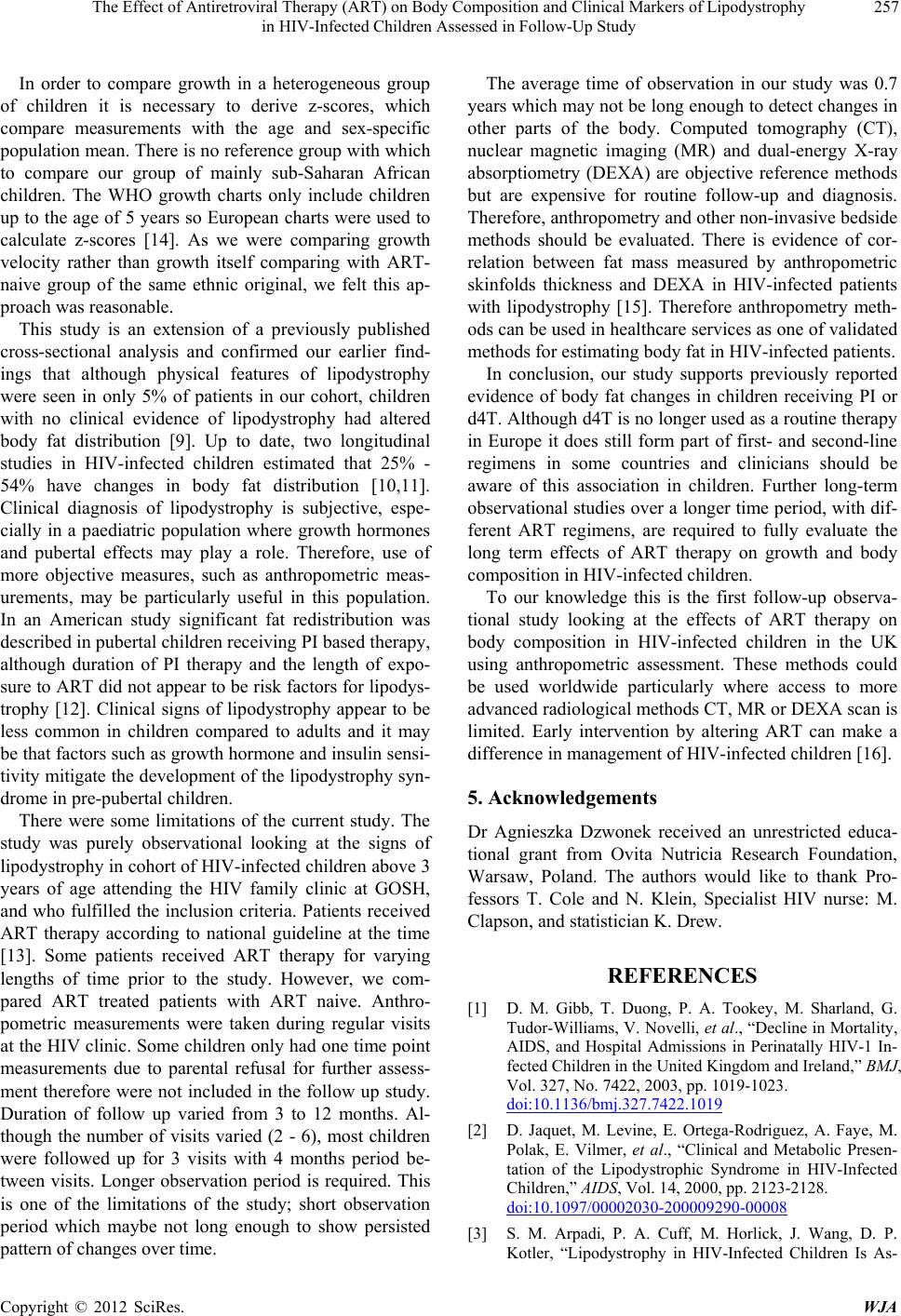
The Effect of Antiretroviral Therapy (ART) on Body Composition and Clinical Markers of Lipodystrophy
in HIV-Infected Children Assessed in Follow-Up Study 257
In order to compare growth in a heterogeneous group
of children it is necessary to derive z-scores, which
compare measurements with the age and sex-specific
population mean. Th ere is no reference group with which
to compare our group of mainly sub-Saharan African
children. The WHO growth charts only include children
up to the age of 5 years so European charts were used to
calculate z-scores [14]. As we were comparing growth
velocity rather than growth itself comparing with ART-
naive group of the same ethnic original, we felt this ap-
proach wa s re asonabl e .
This study is an extension of a previously published
cross-sectional analysis and confirmed our earlier find-
ings that although physical features of lipodystrophy
were seen in only 5% of patients in our cohort, children
with no clinical evidence of lipodystrophy had altered
body fat distribution [9]. Up to date, two longitudinal
studies in HIV-infected children estimated that 25% -
54% have changes in body fat distribution [10,11].
Clinical diagnosis of lipodystrophy is subjective, espe-
cially in a paediatric population where growth hormones
and pubertal effects may play a role. Therefore, use of
more objective measures, such as anthropometric meas-
urements, may be particularly useful in this population.
In an American study significant fat redistribution was
described in pubertal children receiving PI based therapy,
although duration of PI therapy and the length of expo-
sure to ART did not appear to be risk factors for lipodys-
trophy [12]. Clinical signs of lipodystrophy appear to be
less common in children compared to adults and it may
be that factors such as growth hormone and insulin sensi-
tivity mitigate the dev elopment of the lipodystrophy syn-
drome in pre-pubertal children.
There were some limitations of the current study. The
study was purely observational looking at the signs of
lipodystrophy in cohort of HIV-infected children above 3
years of age attending the HIV family clinic at GOSH,
and who fulfilled the inclusion criteria. Patients received
ART therapy according to national guideline at the time
[13]. Some patients received ART therapy for varying
lengths of time prior to the study. However, we com-
pared ART treated patients with ART naive. Anthro-
pometric measurements were taken during regular visits
at the HIV clinic. Some children only had one time point
measurements due to parental refusal for further assess-
ment therefore were not included in the follow up study.
Duration of follow up varied from 3 to 12 months. Al-
though the number of visits varied (2 - 6), most children
were followed up for 3 visits with 4 months period be-
tween visits. Longer observation period is required. This
is one of the limitations of the study; short observation
period which maybe not long enough to show persisted
pattern of changes over time.
The average time of observation in our study was 0.7
years which may not be long enough to de tect changes in
other parts of the body. Computed tomography (CT),
nuclear magnetic imaging (MR) and dual-energy X-ray
absorptiometry (DEXA) are objective reference methods
but are expensive for routine follow-up and diagnosis.
Therefore, anthropometry and other non-invasive bedside
methods should be evaluated. There is evidence of cor-
relation between fat mass measured by anthropometric
skinfolds thickness and DEXA in HIV-infected patients
with lipodystrophy [15]. Therefore anthropometry meth-
ods can be used in healthcare services as one of validated
methods for estimating body fat in HIV-infected patients.
In conclusion, our study supports previously reported
evidence of body fat changes in children receiving PI or
d4T. Although d4T is no longer used as a routine th erapy
in Europe it does still form part of first- and second-line
regimens in some countries and clinicians should be
aware of this association in children. Further long-term
observational studies over a longer time period, with dif-
ferent ART regimens, are required to fully evaluate the
long term effects of ART therapy on growth and body
composition in HIV-infected children.
To our knowledge this is the first follow-up observa-
tional study looking at the effects of ART therapy on
body composition in HIV-infected children in the UK
using anthropometric assessment. These methods could
be used worldwide particularly where access to more
advanced radiological methods CT, MR or DEXA scan is
limited. Early intervention by altering ART can make a
difference in management of HIV-infected children [16].
5. Acknowledgements
Dr Agnieszka Dzwonek received an unrestricted educa-
tional grant from Ovita Nutricia Research Foundation,
Warsaw, Poland. The authors would like to thank Pro-
fessors T. Cole and N. Klein, Specialist HIV nurse: M.
Clapson, and statistician K. Drew.
REFERENCES
[1] D. M. Gibb, T. Duong, P. A. Tookey, M. Sharland, G.
Tudor-Williams, V. Novelli, et al., “Decline in Mortality,
AIDS, and Hospital Admissions in Perinatally HIV-1 In-
fected Children in the United Kingdom and Ireland,” BMJ,
Vol. 327, No. 7422, 2003, pp. 1019-1023.
doi:10.1136/bmj.327.7422.1019
[2] D. Jaquet, M. Levine, E. Ortega-Rodriguez, A. Faye, M.
Polak, E. Vilmer, et al., “Clinical and Metabolic Presen-
tation of the Lipodystrophic Syndrome in HIV-Infected
Children,” AIDS, Vol. 14, 2000, pp. 2123-2128.
doi:10.1097/00002030-200009290-00008
[3] S. M. Arpadi, P. A. Cuff, M. Horlick, J. Wang, D. P.
Kotler, “Lipodystrophy in HIV-Infected Children Is As-
Copyright © 2012 SciRes. WJA